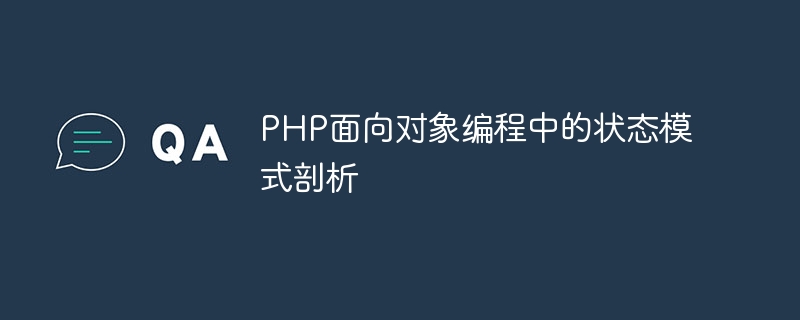Home >Backend Development >PHP Tutorial >Analysis of state pattern in PHP object-oriented programming
Analysis of state pattern in PHP object-oriented programming
- WBOYWBOYWBOYWBOYWBOYWBOYWBOYWBOYWBOYWBOYWBOYWBOYWBOriginal
- 2023-08-13 13:15:30761browse

Analysis of the state pattern in PHP object-oriented programming
Introduction:
In object-oriented programming, the state pattern is a common design pattern. It allows an object to change its behavior when its internal state changes, while making these changes transparent to external objects. In PHP, the state pattern can be used to handle different states and behaviors of objects gracefully, improving the readability and maintainability of the code. This article will introduce the state pattern in PHP in detail, including its definition and implementation, as well as some common application scenarios.
1. Overview of the state pattern
The state pattern is a behavioral design pattern that changes the object's behavior by encapsulating the object's behavior in different state classes. An object has different behaviors in different states, and the state pattern encapsulates each specific state into a separate class. The object only needs to change its internal state in different states without changing its behavior. This makes it easier to switch the state of the object, and also improves the maintainability and scalability of the code.
2. Implementation of the state pattern
In PHP, implementing the state pattern usually requires the use of abstract classes and polymorphic features. First, we define an abstract state class (State), which defines the behavior interface of the object in different states. Then, each concrete state class (ConcreteState) inherits the abstract state class and implements the behavior in the concrete state. Finally, we define an environment class (Context), which contains the current state and behavior of the object.
Code example:
// 抽象状态类
abstract class State {
abstract public function handle();
}
// 具体状态类1
class ConcreteState1 extends State {
public function handle() {
echo "当前状态是状态1,执行某些操作。
";
}
}
// 具体状态类2
class ConcreteState2 extends State {
public function handle() {
echo "当前状态是状态2,执行其他操作。
";
}
}
// 环境类
class Context {
private $state;
public function __construct() {
$this->state = new ConcreteState1(); // 默认状态为状态1
}
public function setState(State $state) {
$this->state = $state;
}
public function request() {
$this->state->handle();
}
}
// 使用示例
$context = new Context(); // 创建环境对象
$context->request(); // 输出:当前状态是状态1,执行某些操作。
$context->setState(new ConcreteState2()); // 切换状态为状态2
$context->request(); // 输出:当前状态是状态2,执行其他操作。In the above code, the abstract state class (State) defines a unified behavior interface, and the concrete state classes (ConcreteState1 and ConcreteState2) inherit the abstract state class and implement specific behaviors. . The environment class (Context) contains instances of the current state and methods for performing actions based on the current state. By switching states in the environment class, you can change the behavior of the object.
3. Application scenarios of status mode
The status mode has a wide range of application scenarios in practical applications. The following are some common application scenarios:
- Order status management: in In the e-commerce system, orders have different statuses, such as pending payment, paid, shipped, etc. You can use the status pattern to manage order status switching to simplify order processing logic.
- Game character state management: In game development, game characters have different states, such as normal state, injured state, dead state, etc. You can use the state mode to manage the state switching and corresponding behaviors of game characters.
- Workflow management: In the workflow management system, different process nodes have different statuses, such as to-do, in progress, completed, etc. You can use the state pattern to manage workflow state switching and process execution.
Summary:
This article introduces the state pattern in PHP in detail, including its definition, implementation and application scenarios. The state pattern allows objects to have different behaviors in different states, thereby improving the readability and maintainability of code. I hope readers can flexibly use the state pattern in actual development to improve code quality.
The above is the detailed content of Analysis of state pattern in PHP object-oriented programming. For more information, please follow other related articles on the PHP Chinese website!

